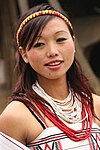Naga people
According to the Burma Gazetteer, the term 'Naga' is of doubtful origin and is used to describe hill tribes that occupy the country between the Chins in the south and Kachins (Singphos) in the Northeast.[9] According to the Burmese chronicles Tagung Yazawin, the first Chaopha of Mongkawng Samlongpha (1150–1201 CE) with the main town in Mogaung captured Naga country in the early 1200s.[10] According to the History of Hsenwi state chronicle and Mengguo Zhanbi, in 1318, Si Kefa, the ruler of Mongmao appointed his brother Sanlongfa as the general and led an army of 90,000 to attack the king of Mong Wehsali Long ( Assam).[11][12] In Yan-aung-myin Pagoda inscription found in Pinya of Myanmar mentions that the Kingdom of Ava under Minkhaung I (1400–1421) in the early 1400s extended till the territories of the Nagas.They use beads in variety, profusion and complexity in their jewelry, along with a wide range of materials including glass, shell, stone, teeth or tusk, claws, horns, metal, bone, wood, seeds, hair, and fibre.The early Western missionaries opposed the use of folk songs by Naga Christians as they were perceived to be associated with spirit worship, war, and immorality.In Myanmar, the term "Naga" holds significance in Buddhist mythology, referring to serpent-like beings often depicted in religious art and architecture.[26] Today, it covers a number of ethnic groups that reside in Nagaland, Manipur, Assam and Arunachal Pradesh states of India, and also in Myanmar.This expansion in the "Naga" identity has been due to a number of factors including the quest for upward mobility in the society of Nagaland, and the desire to establish a common purpose of resistance against dominance by other groups.The Naga territory in Myanmar is marked by Kabaw valley in the south bordering to the Chin state, the Kachin on the north and the Burmese on the east.Naga people, indigenous to northwestern Myanmar and northeastern India exhibit a complex genetic profile shaped by ancient migrations and interactions with neighboring populations.This connection suggests a significant ancestral lineage from regions in and around the upper-middle Yellow River basin, indicating ancient migrations from East Asia into the Indian subcontinent.[31] Genetic studies have also identified that Naga males predominantly belong to Y chromosome haplogroups associated with East and Southeast Asia populations.This haplogroup is linked to ancient migrations from the upper-middle Yellow River basin, suggesting a deep ancestral connection to East Asian lineages.










Naga woman
Naga (disambiguation)National flag of the Naga peopleSümi NagasNagalandManipurArunachal PradeshMeghalayaMizoramMyanmarNaga SAZSagaing DivisionKachin StateNorthern NagaNagamese CreoleEnglishBurmeseChristianityBaptistBuddhismHinduismAnimismHerakaRangfrahTingkao Ragwang ChapriakKachinJingpoSoutheast AsianTibeto-Burmanethnic groupsnortheastern IndiaIndian stateNaga Self-Administered ZoneSagaing RegionNaga ethnic groupsNaga languagesAhom kingdomMeitei peopleImphal ValleyKachinsSingphosHistory of the NagasheadhuntingBritish ruleIndian citizensongoing ethnic conflictTagung YazawinChaophaMongkawngMogaungMong MaoSi KefaHsenwi stateMongmaoYan-aung-myin PagodaKingdom of AvaMinkhaung IVerrier ElwinmekhalaGeographical IndicationakhuniNaga cuisineChristianity in NagalandList of traditional Naga festivalsHornbill FestivalLui Ngai NiAoleangKonyakGaan-NgaiZeliangrongLiangmeiRongmeiTamenglongCacharChandelChiithuniSenapatiLainongTangkhulUkhrulMetümnyoYimkhiungShamatorKhiamniunganNoklakMokokchungMungmungSangtamKiphireMonyüLonglengNaknyulümTuensangRengmaTseminyüSekrenyiAngamiKohimaChümoukedimaChakhesangPoumaiTokhü EmongZünhebotoPochuryList of Naga ethnic groupsexonymSumi NagaAssamesescheduled tribesKabaw valleyChin stateMakurySomra TangkhulTangshangLamkangLongphuriPaung NyuanHomalinLayshiHkamtiNanyunPangsauTamu townshipSomra NagasHomalin townshipHomlinRed Shans
